Preparing for the CMA demands a thorough understanding of Planning, Budgeting, and Forecasting, vital for excelling in Financial Planning and Analysis. Mastering the processes behind strategic goal setting, resource allocation, and financial projection equips you with essential skills for evaluating performance and guiding decision-making. Key areas include budgeting techniques, forecasting methods, variance analysis, and the application of ethical standards, all critical for ensuring accuracy and transparency in financial management, which is fundamental for success on the CMA exam and effective organizational leadership.
Learning Objective
In studying "Planning, Budgeting, and Forecasting" for the CMA Exam, you should develop an understanding of the methods for setting financial goals, allocating resources, and projecting outcomes that support strategic decision-making. Explore the roles of various budgeting techniques, forecasting approaches, and variance analysis in aligning operations with objectives. Evaluate how these processes ensure financial accountability and performance optimization. Additionally, understand how these practices form the foundation for ethical financial management and resource planning. Apply this knowledge to analyzing budgets, interpreting forecasts, and solving CMA practice questions on budgeting strategies, forecasting accuracy, and variance reconciliation.
1. Overview of Planning, Budgeting, and Forecasting
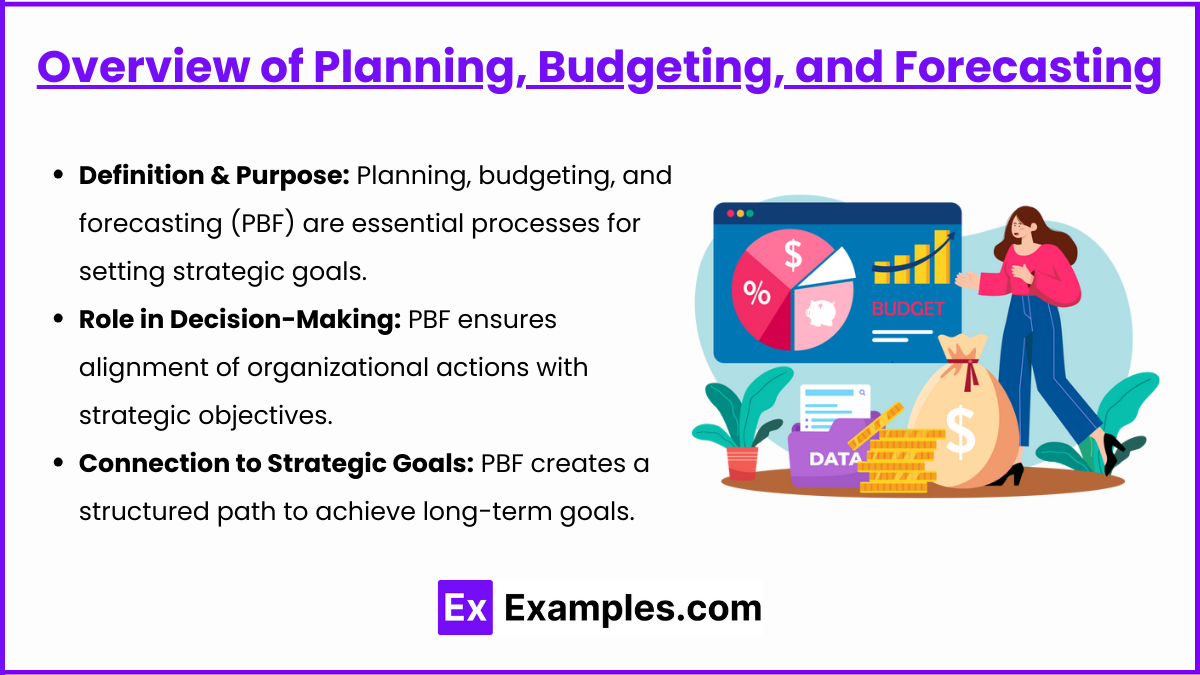
Definition & Purpose: Planning, budgeting, and forecasting (PBF) are processes used to define strategic goals, allocate resources, and predict future financial outcomes.
Role in Decision-Making: PBF aligns organizational activities with strategic objectives, provides financial guidance, and supports managerial decisions.
Link to Strategic Goals: Establishes a roadmap to meet long-term goals through short-term objectives.
2. The Planning Process
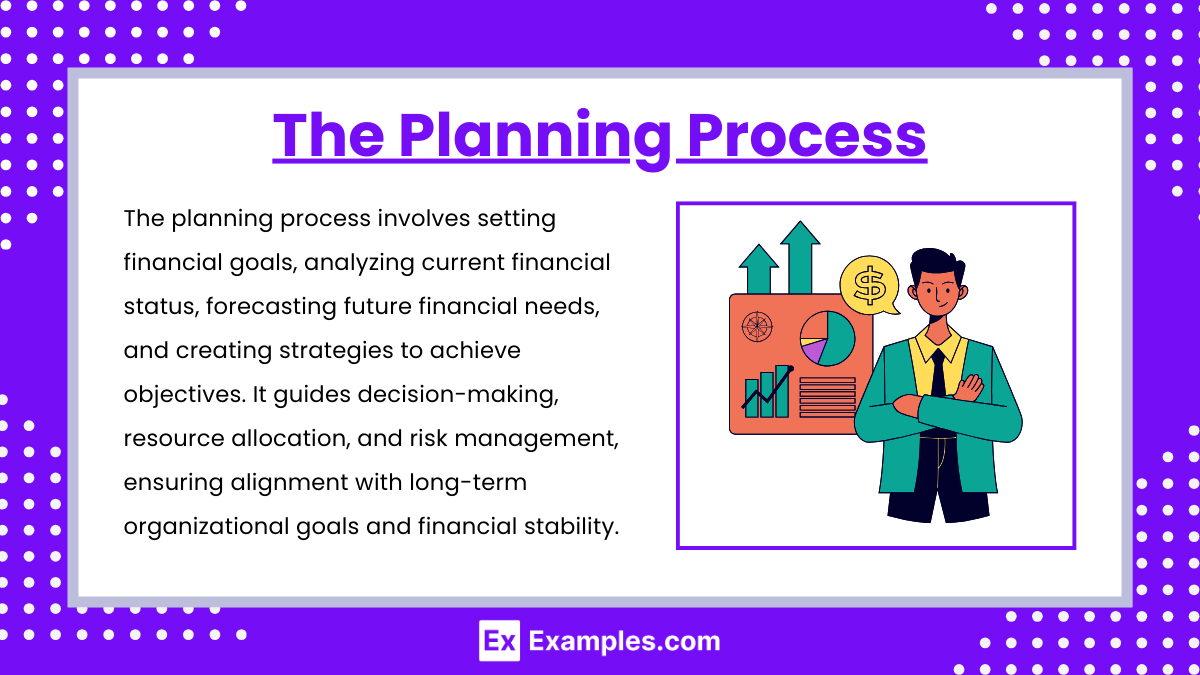
Strategic Planning: Long-term vision and objectives, typically spanning 3-5 years, focusing on broad goals.
Operational Planning: Breaks down strategic goals into operational tasks, covering resource allocation, staffing, and operational schedules.
Tactical Planning: Medium-term plans, usually covering 1-3 years, supporting strategic goals with detailed actions and benchmarks.
Contingency Planning: Prepares for potential changes and risks, enabling the organization to adapt to unforeseen circumstances.
3. Budgeting Techniques
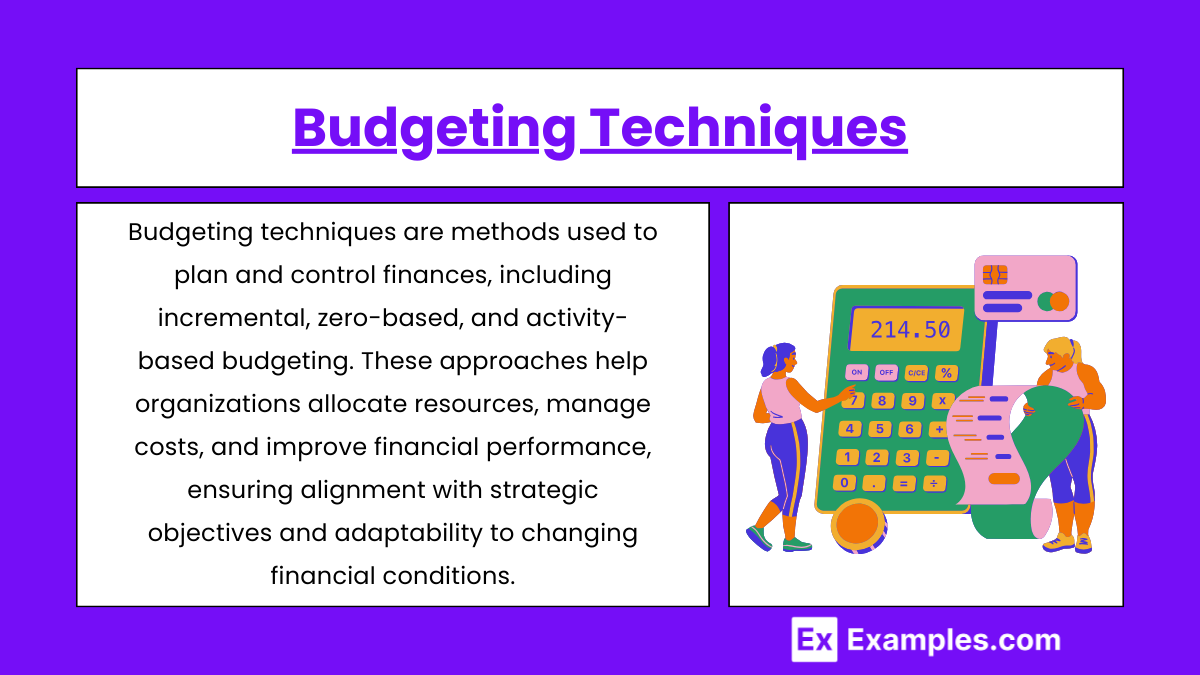
Types of Budgets:
Operating Budget: Forecasts income and expenses, aiding in day-to-day operations.
Capital Budget: Allocates funds for long-term asset investments, ensuring strategic asset allocation.
Cash Budget: Ensures liquidity management by predicting cash inflows and outflows.
Flexible Budget: Adjusts based on varying levels of activity, allowing for responsiveness to changes.
Budgeting Approaches:
Incremental Budgeting: Uses last period’s budget as a baseline, adjusting incrementally.
Zero-Based Budgeting (ZBB): Starts from zero, evaluating all expenses afresh, ensuring cost-efficiency.
Activity-Based Budgeting (ABB): Focuses on activities driving costs, aligning resources directly with operational activities.
Budget Cycle Phases:
Preparation: Gathering historical data and setting objectives.
Review & Approval: Higher management reviews and approves budgets to ensure alignment.
Execution: Implementing budgeted activities and tracking performance.
Monitoring and Adjusting: Ongoing review and modification based on actual performance.
4. Forecasting Techniques
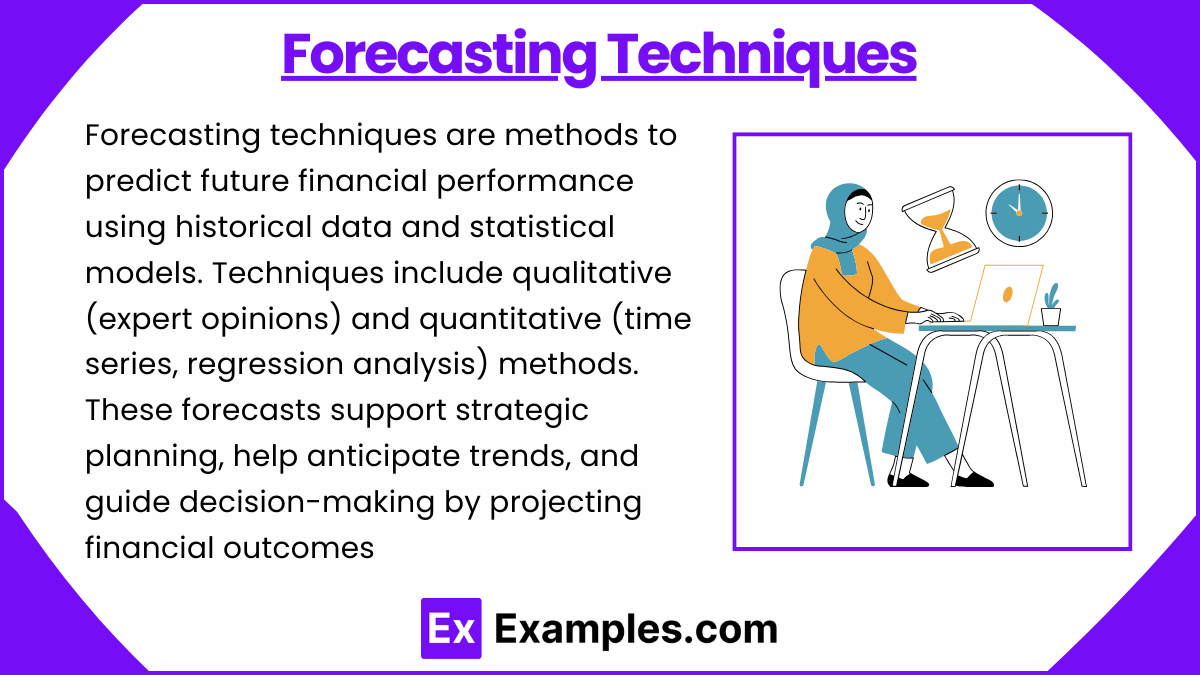
Qualitative Forecasting:
Delphi Method: Uses expert consensus to predict future trends.
Market Research: Analyzes consumer trends to project future demand.
Quantitative Forecasting:
Time Series Analysis: Analyzes historical data to predict future trends (e.g., moving averages, exponential smoothing).
Regression Analysis: Establishes relationships between variables to forecast future performance.
Scenario Analysis: Projects outcomes based on various “what-if” scenarios, allowing management to prepare for multiple potential outcomes.
5. Variance Analysis
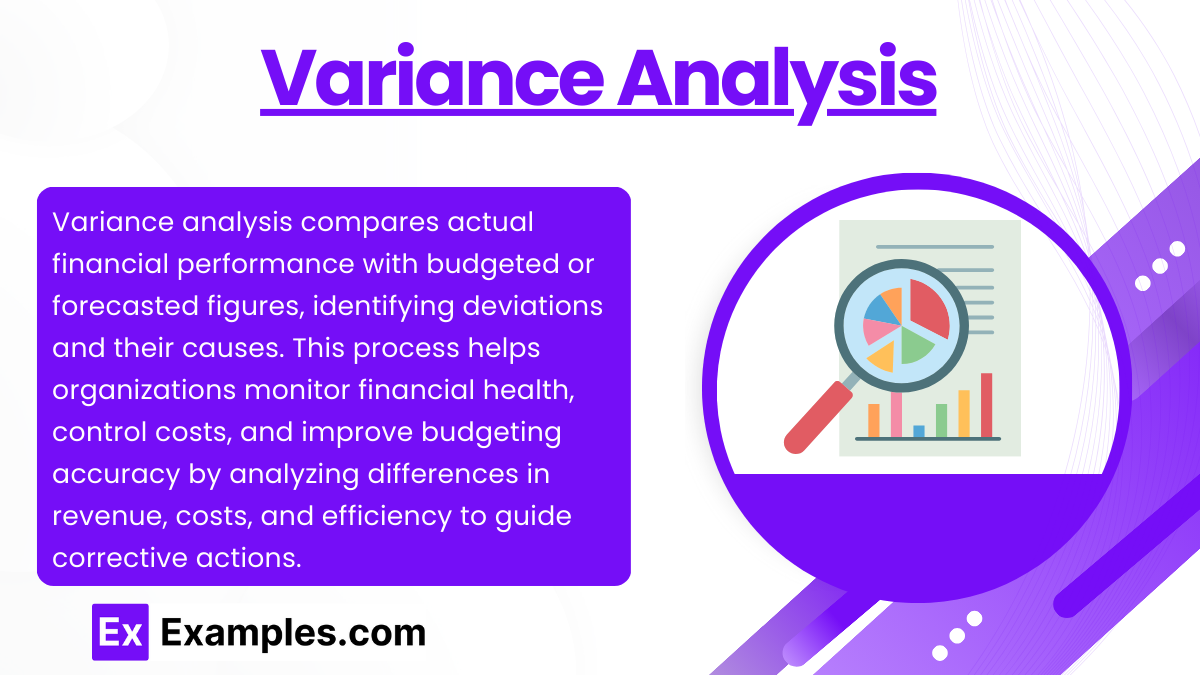
Purpose: Identifies deviations between actual performance and budgeted/forecasted outcomes to guide corrective actions.
Types of Variances:
Sales Variance: Compares actual vs. budgeted sales, examining volume and price factors.
Cost Variance: Analyzes differences in budgeted vs. actual costs, focusing on efficiency and price deviations.
Analysis & Interpretation:
Favorable vs. Unfavorable: Determining if variances help (favorable) or hinder (unfavorable) performance.
Root Cause Analysis: Identifying underlying reasons for variances to improve future planning accuracy.
Examples
Example 1: Setting Strategic Goals in Planning
Defining Strategic Goals: Strategic goals are high-level objectives that guide overall business direction, typically set for a 3-5 year timeframe.
SMART Goals Framework: Goals should be Specific, Measurable, Achievable, Relevant, and Time-bound, ensuring clarity and focus in financial planning.
Application: For instance, a company may set a strategic goal to increase market share by 20% within the next 3 years, aligning all budgeting and forecasting efforts towards this objective.
Example 2: Types of Budgets and Their Purpose
Operating Budget: Outlines expected revenue and expenses for daily operations, helping to maintain operational efficiency.
Capital Budget: Plans for long-term asset purchases, such as equipment or real estate, ensuring strategic asset allocation.
Flexible Budget: Adjusts for varying levels of activity, enabling responsiveness to market or production changes.
Application: A manufacturing company uses a flexible budget to accommodate seasonal demand fluctuations, ensuring efficient resource allocation.
Example 3: Forecasting Techniques in Financial Planning
Qualitative Forecasting: Relies on expert opinions, such as the Delphi method, useful in unpredictable or new markets.
Quantitative Forecasting: Uses statistical models like time series analysis and regression to project future financial outcomes based on historical data.
Scenario Analysis: Examines different "what-if" situations, helping managers prepare for diverse financial conditions.
Application: A retail company forecasts sales for the holiday season using time series analysis, adjusting inventory levels accordingly.
Example 4: Variance Analysis for Performance Improvement
Variance Analysis: Compares budgeted figures to actual performance, identifying deviations that can guide corrective actions.
Types of Variances: Sales variance, cost variance, and efficiency variance are commonly analyzed to detect sources of financial discrepancies.
Application: A company performs a variance analysis to understand why actual production costs exceeded the budget, leading to adjustments in supplier negotiations.
Example 5: Ethical Standards in Planning, Budgeting, and Forecasting
Transparency and Integrity: Ethical standards demand accuracy and honesty in reporting to build stakeholder trust.
Confidentiality: Financial data used in PBF must be protected to maintain competitive advantage and respect privacy.
Application: A financial analyst ensures accuracy in forecasting reports and refrains from sharing sensitive information, upholding ethical standards and regulatory compliance.
Practice Questions
Question 1:
What is the primary purpose of an operating budget in financial planning?
A) To forecast cash flows
B) To plan for long-term asset purchases
C) To outline day-to-day revenue and expenses
D) To compare actual results with projected outcomes
Answer: C) To outline day-to-day revenue and expenses
Explanation: The operating budget focuses on short-term financial planning, covering daily operational revenues and expenses, critical for managing routine business activities.
Question 2:
Which budgeting method requires all expenses to be reviewed and justified, ensuring cost-effectiveness in each period?
A) Incremental Budgeting
B) Zero-Based Budgeting
C) Capital Budgeting
D) Flexible Budgeting
Answer: B) Zero-Based Budgeting
Explanation: Zero-Based Budgeting starts from zero each time, requiring justification for all expenses, which promotes cost control and efficient resource use.
Question 3:
Which of the following best describes the purpose of scenario analysis in forecasting?
A) Simplifying budget creation by using historical data
B) Providing flexibility in adjusting the operating budget
C) Preparing for different potential financial situations
D) Ensuring compliance with regulatory standards
Answer: C) Preparing for different potential financial situations
Explanation: Scenario analysis examines multiple "what-if" scenarios, allowing organizations to be better prepared for uncertain outcomes by analyzing varied financial impacts.


